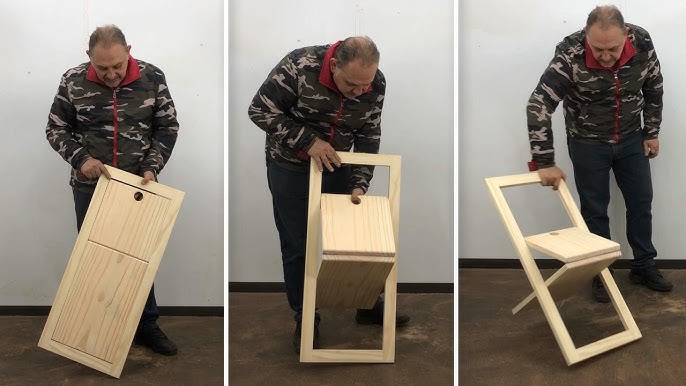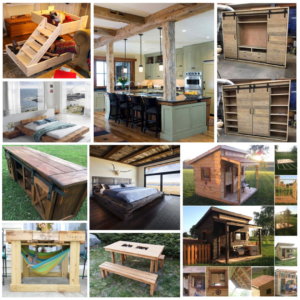How to Make a Secret Foldable Chair
Creating a foldable chair at home can be a fun and practical DIY project.
While I can’t provide detailed step-by-step plans, I can certainly give you a general idea of how to approach making a simple foldable chair.
Keep in mind that this is a basic guide and may not result in an actual “secret” chair, but it will help you create a foldable chair that’s easy to store and transport.
**Materials You’ll Need:**
– Plywood or strong wooden boards
– Hinges
– Screws
– Screwdriver
– Saw
– Measuring tape
– Sandpaper
– Varnish or paint (optional, for finishing)
– Safety gear (gloves, safety glasses, etc.)
**Steps:**
1. **Design and Measurements:** Determine the size and design of your foldable chair. Keep it simple, as complex designs might be more challenging to fold and unfold. Measure and mark the dimensions for the seat, backrest, and legs. It’s a good idea to sketch out your design on paper before you begin.
2. **Cutting the Wood:** Use a saw to cut the plywood or wooden boards according to the measurements you’ve marked. You’ll need pieces for the seat, backrest, and legs. Sand the edges and surfaces of the wood to smooth out any rough spots.
3. **Creating the Seat and Backrest:** Attach hinges to one side of the seat piece and the corresponding side of the backrest piece. This will allow the backrest to fold down onto the seat. Make sure the hinges are securely screwed in.
4. **Attaching the Legs:** Attach legs to the underside of the seat using hinges as well. These legs will fold up underneath the seat when the chair is collapsed. Ensure that the hinges are properly aligned to allow smooth folding and unfolding of the legs.
5. **Finishing Touches:** Once the basic structure is complete, you can apply varnish or paint to protect the wood and enhance its appearance. Allow the finish to dry completely before using the chair.
6. **Testing and Adjustments:** Test your foldable chair by unfolding and setting it up. Ensure that all hinges are working smoothly and that the chair is stable when open. If needed, make any adjustments or reinforce weak points.
Remember that this is a basic outline, and the complexity of the project may vary based on your design and woodworking skills. If you’re not comfortable with woodworking or using tools, it’s a good idea to seek assistance from someone with experience. Also, keep safety in mind at all times when working with tools and materials.
As for making it a “secret” foldable chair, you could incorporate unique ways to hide its folding mechanisms or give it a disguised appearance when folded, but that would likely add an additional layer of complexity to the project.

How to Make a Secret Foldable Chair: pros and cons
Creating a secret foldable chair can be a challenging and creative DIY project.
Here are 25 pros and cons to consider when making a secret foldable chair at home:
**Pros:**
1. **Space-Saving:** A secret foldable chair allows you to save space when the chair is not in use, making it ideal for small living spaces.
2. **Ingenious Design:** Building a secret foldable chair showcases your creativity and craftsmanship.
3. **Concealed Appearance:** The chair’s hidden nature adds an element of surprise and intrigue.
4. **Conversation Starter:** Guests will be impressed by the cleverness of your secret chair design.
5. **Customization:** You can tailor the chair’s design to match your decor and style preferences.
6. **Functional Art Piece:** A well-designed secret chair can be both functional furniture and a piece of art.
7. **Learning Experience:** This project offers an opportunity to learn about woodworking, hinges, and hidden mechanisms.
8. **Satisfaction:** Completing a complex project like this can be incredibly rewarding.
9. **Unique Furniture:** Your secret foldable chair will stand out as a unique and memorable piece.
10. **Teaching Opportunity:** You can involve others, like family members or children, in the building process.
11. **Admiration:** Friends and family will likely admire your craftsmanship and ingenuity.
12. **Home Improvement:** The project contributes to home improvement and adds a new feature to your space.
13. **Flexibility:** You can experiment with different folding mechanisms and styles.
14. **Practicality:** The chair can be used when needed and hidden away when not in use.
15. **Portable:** Secret foldable chairs can be transported easily due to their compact nature.
16. **Fun Gift Idea:** Consider giving a secret foldable chair as a unique and thoughtful gift.
17. **Resourceful:** You’re repurposing space in a clever and resourceful way.
18. **Conversation Piece:** Guests will be curious and fascinated by the chair’s hidden design.
19. **Personal Challenge:** Building a secret chair presents a challenge that can improve your skills.
20. **Functional Surprise:** Your guests will be surprised when you reveal the hidden chair.
21. **Useful in Gatherings:** The extra seating can be useful during gatherings and events.
22. **Hidden Storage:** Some designs can incorporate hidden storage compartments within the chair.
23. **Sense of Accomplishment:** Completing such a project boosts your confidence in tackling DIY tasks.
24. **Interior Aesthetics:** The chair contributes to a clutter-free interior when not in use.
25. **Showcase Piece:** The chair can become a showcase piece for your woodworking abilities.

**Cons:**
1. **Complexity:** Building a secret foldable chair can be complex, requiring advanced woodworking skills.
2. **Time-Consuming:** The project might take a considerable amount of time to complete.
3. **Cost:** Depending on the materials and tools you use, the project could be costly.
4. **Tools Required:** You’ll need specialized tools and equipment for accurate woodworking.
5. **Space Requirements:** Adequate space is necessary to work on and assemble the chair.
6. **Frustration:** Complex projects can lead to frustration if not executed correctly.
7. **Skill Level:** The project might be too challenging for beginners or those with limited woodworking experience.
8. **Trial and Error:** Developing the folding mechanism might involve trial and error.
9. **Precision Needed:** Accurate measurements and precise cuts are essential for a functional chair.
10. **Design Challenges:** Designing a hidden mechanism that works seamlessly can be difficult.
11. **Safety Concerns:** Working with tools poses safety risks if not done carefully.
12. **Limited Weight Capacity:** The chair might have a lower weight capacity due to the folding mechanism.
13. **Durability:** Ensuring the chair is durable and stable might require extra effort.
14. **Maintenance:** The chair’s hidden mechanisms might need occasional maintenance.
15. **Limited Online Resources:** Finding detailed guides or plans for a secret chair could be challenging.
16. **Unforeseen Issues:** Hidden challenges might arise during the construction process.
17. **Material Availability:** Finding suitable materials for the project might be difficult.
18. **Space Limitations:** The chair might not be suitable for larger individuals due to its compact size.
19. **Transportation Challenges:** The chair’s unique design might make it tricky to transport.
20. **Unpredictable Results:** Achieving the desired results might be unpredictable, especially if it’s your first attempt.
21. **Weight Restrictions:** The chair might not accommodate heavier individuals due to its design.
22. **Skill Acquisition:** Developing the required skills might take time and practice.
23. **Lack of Experience:** Inexperience might lead to design flaws or structural weaknesses.
24. **Resource Intensive:** The project requires a significant investment of time, effort, and materials.
25. **Disappointment:** If the chair doesn’t function as expected, it could lead to disappointment.
Before embarking on such a project, carefully weigh the pros and cons based on your skills, resources, and commitment.
If you’re up for the challenge, a secret foldable chair can be a rewarding addition to your home.

How to Make a Secret Foldable Chair: Best kind of wood
Creating a secret foldable chair requires careful planning and selection of appropriate materials. Here’s a guide on how to make one using the best 15 types of wood for the project:
**Materials You’ll Need:**
– Wood (Select from the list below)
– Hinges
– Screws
– Screwdriver
– Saw
– Measuring tape
– Sandpaper
– Varnish or paint (optional, for finishing)
– Safety gear (gloves, safety glasses, etc.)
**15 Best Types of Wood for the Project:**
1. **Oak:** Durable and strong, oak is a classic choice for furniture projects due to its appealing grain and resistance to wear.
2. **Maple:** Known for its light color and uniform grain, maple is sturdy and often used for fine furniture.
3. **Cherry:** This hardwood boasts a rich reddish-brown color and smooth grain, making it a popular choice for high-quality furniture.
4. **Walnut:** Walnut’s dark color and unique grain patterns add a touch of elegance to furniture projects.
5. **Birch:** Light in color and easy to work with, birch is a good choice for those looking for a more affordable yet attractive wood.
6. **Mahogany:** Highly prized for its deep, reddish-brown color and luxurious appearance, mahogany is often used for fine furniture.
7. **Ash:** With a pale color and excellent strength-to-weight ratio, ash is a versatile choice for furniture making.
8. **Hickory:** Known for its strength and toughness, hickory is a great option if durability is a priority.
9. **Beech:** With a pale color and tight grain, beech is both sturdy and easy to work with.
10. **Cedar:** Cedar’s pleasant aroma and resistance to decay make it suitable for both indoor and outdoor projects.
11. **Pine:** Affordable and readily available, pine’s light color and knotty texture can lend a rustic charm to your project.
12. **Redwood:** If you need a wood that’s naturally resistant to insects and rot, redwood is a solid choice for outdoor furniture.
13. **Teak:** Known for its exceptional weather resistance, teak is often used in outdoor furniture due to its natural oils.
14. **Ipe:** Another excellent choice for outdoor furniture, ipe is incredibly dense and durable, with a rich reddish-brown color.
15. **Ebony:** For a touch of luxury and sophistication, ebony’s dark color and fine texture can elevate your project.

**Steps:**
1. **Design and Measurements:** Sketch your secret foldable chair design, considering the folding mechanism and size of the chair.
2. **Wood Selection:** Choose the best type of wood from the list based on availability, budget, and desired aesthetics.
3. **Cutting the Wood:** Use a saw to cut the wood pieces according to your design. You’ll need pieces for the seat, backrest, and legs.
4. **Hinge Placement:** Attach hinges to the necessary parts, considering the folding points. Ensure they’re securely screwed in.
5. **Assembly:** Attach the hinges to connect the seat, backrest, and legs, forming the foldable structure.
6. **Sand and Finish:** Smooth the edges and surfaces of the wood using sandpaper. Apply varnish or paint for protection and aesthetics.
7. **Testing and Adjustments:** Test the foldable chair to ensure the hinges work smoothly and the chair is stable in both folded and unfolded positions.
8. **Final Touches:** Make any necessary adjustments for stability, function, and appearance.
Remember that woodworking requires precision and safety precautions. Always wear appropriate safety gear, and if you’re new to woodworking, consider seeking guidance from someone with experience.
Creating a secret foldable chair with high-quality wood can result in a stunning and functional piece of furniture that you can be proud of.

How to Make a Secret Foldable Chair: 17 best ways
Creating a simple secret foldable chair at home can be a fun and practical project. Here are 17 straightforward ways to make one:
**Materials You’ll Need:**
– Plywood or wooden boards
– Hinges
– Screws
– Screwdriver
– Saw
– Measuring tape
– Sandpaper
– Varnish or paint (optional, for finishing)
– Safety gear (gloves, safety glasses, etc.)
**Steps:**
1. **Design and Measurements:** Sketch a simple design for your foldable chair, including the seat, backrest, and legs. Measure and mark the dimensions accordingly.
2. **Cutting the Wood:** Use a saw to cut the plywood or wooden boards into the pieces needed for the seat, backrest, and legs.
3. **Seat and Backrest:** Attach hinges to one side of the seat and the corresponding side of the backrest. This will allow the backrest to fold down onto the seat. Secure the hinges with screws.
4. **Legs:** Attach hinges to the underside of the seat and the legs. These legs will fold up underneath the seat. Ensure proper alignment for smooth folding.
5. **Assembly:** Attach the legs to the hinges on the seat. Secure the hinges with screws to create a stable foldable structure.
6. **Sand and Finish:** Smooth any rough edges and surfaces using sandpaper. Apply varnish or paint for protection and aesthetics if desired. Allow it to dry.
7. **Testing:** Test the chair by unfolding and setting it up. Ensure the hinges work smoothly and the chair is stable when open.
8. **Adjustments:** Make any necessary adjustments to the hinges or structure for optimal functionality.
9. **Hidden Mechanism:** To add a touch of secrecy, consider placing a decorative cover over the hinges to conceal them when the chair is folded.
10. **Hooks or Latches:** Add small hooks or latches to keep the chair securely folded when not in use.
11. **Handles:** Attach handles to the chair’s sides for easy transportation when folded.
12. **Color and Design:** Use paint or stencils to decorate the chair, making it aesthetically pleasing and unique.
13. **Cushioning:** Add a cushion to the seat and backrest for extra comfort.
14. **Stenciled Patterns:** Consider stenciling patterns onto the chair for a personalized touch.
15. **Compact Storage:** Ensure the chair folds compactly to save space when not in use.
16. **Weight Capacity:** Keep in mind the weight capacity of the chair and choose sturdy materials and hinges accordingly.
17. **Experiment with Materials:** If you’re looking for a simpler design, you can use thick cardboard or other sturdy materials instead of wood.
Remember that while these steps outline a simple approach, precision and safety are important when working with tools and materials.
If you’re new to DIY or woodworking, consider seeking guidance or assistance from someone experienced.

How to Make a Secret Foldable Chair: at Home indoor or outdoor
Creating a secret foldable chair for indoor or outdoor use can be a practical and enjoyable DIY project. Here’s how you can make one for both settings:
**Materials You’ll Need:**
– Plywood or wooden boards (for indoor)
– Weather-resistant wood or treated lumber (for outdoor)
– Hinges
– Screws
– Screwdriver
– Saw
– Measuring tape
– Sandpaper
– Varnish or outdoor paint (for outdoor)
– Safety gear (gloves, safety glasses, etc.)

**Steps:**
**For Indoor Use:**
1. **Design and Measurements:** Sketch a simple design for the indoor foldable chair, including the seat, backrest, and legs. Measure and mark the dimensions accordingly.
2. **Cutting the Wood:** Use a saw to cut the plywood or wooden boards into the pieces needed for the seat, backrest, and legs.
3. **Seat and Backrest:** Attach hinges to one side of the seat and the corresponding side of the backrest. Secure the hinges with screws.
4. **Legs:** Attach hinges to the underside of the seat and the legs. Ensure proper alignment for smooth folding.
5. **Assembly:** Attach the legs to the hinges on the seat. Secure the hinges with screws to create a stable foldable structure.
6. **Sand and Finish:** Smooth any rough edges and surfaces using sandpaper. Apply varnish or paint for protection and aesthetics if desired. Allow it to dry.
7. **Testing and Adjustments:** Test the chair by unfolding and setting it up. Ensure the hinges work smoothly and the chair is stable when open.
8. **Decorative Cover:** To add an indoor aesthetic, consider placing a decorative cover over the hinges to conceal them when the chair is folded.
**For Outdoor Use:**
1. **Design and Measurements:** Sketch a design for the outdoor foldable chair, taking weather resistance into account. Measure and mark the dimensions accordingly.
2. **Cutting the Wood:** Use a saw to cut the weather-resistant wood or treated lumber into the pieces needed for the seat, backrest, and legs.
3. **Seat and Backrest:** Attach weather-resistant hinges to one side of the seat and the corresponding side of the backrest. Secure the hinges with weather-resistant screws.
4. **Legs:** Attach weather-resistant hinges to the underside of the seat and the legs. Ensure proper alignment for smooth folding.
5. **Assembly:** Attach the legs to the hinges on the seat. Secure the hinges with weather-resistant screws to create a stable foldable structure.
6. **Sand and Finish:** Smooth any rough edges and surfaces using sandpaper. Apply outdoor varnish or paint designed to withstand the elements for protection and aesthetics. Allow it to dry.
7. **Weatherproofing:** Ensure all the joints and hinges are properly sealed to prevent moisture penetration.
8. **Testing and Adjustments:** Test the chair by unfolding and setting it up. Ensure the hinges work smoothly and the chair is stable when open.
Remember to consider the weight capacity, durability, and safety features when designing and building your foldable chair for either indoor or outdoor use.
Additionally, follow proper safety practices while using tools and equipment.

How to Make a Secret Foldable Chair at Home: step by step plans
Creating a step-by-step guide for a secret foldable chair involves detailing each stage of the process.
Below are comprehensive instructions for making a secret foldable chair at home:
**Materials You’ll Need:**
– Plywood or wooden boards
– Hinges
– Screws
– Screwdriver
– Saw
– Measuring tape
– Sandpaper
– Varnish or paint (optional, for finishing)
– Safety gear (gloves, safety glasses, etc.)
**Step-by-Step Guide:**
**Step 1: Design and Measurements**
1. Sketch your foldable chair’s design on paper, including dimensions for the seat, backrest, and legs.
2. Consider a design that allows the chair to fold into a compact form while maintaining stability.
**Step 2: Cutting the Wood**
1. Use a saw to cut the plywood or wooden boards into the necessary pieces based on your design.
2. Cut pieces for the seat, backrest, and legs.
**Step 3: Seat and Backrest**
1. Attach hinges to one side of the seat piece and the corresponding side of the backrest piece using screws.
2. Ensure the hinges are securely fastened to the wood.
**Step 4: Legs**
1. Attach hinges to the underside of the seat and the legs that will fold up.
2. Make sure the hinges align properly to allow smooth folding and unfolding of the legs.
**Step 5: Assembly**
1. Attach the legs to the hinges on the seat, creating the folding mechanism.
2. Secure the hinges with screws to ensure stability.
**Step 6: Sand and Finish**
1. Use sandpaper to smooth any rough edges and surfaces on the chair.
2. Apply varnish or paint for protection and an appealing finish. Let it dry completely.

**Step 7: Testing and Adjustments**
1. Test the chair by unfolding it and setting it up.
2. Ensure the folding mechanism works smoothly, and the chair is stable when opened.
**Step 8: Hidden Mechanism (Optional)**
1. For a “secret” touch, consider adding a decorative cover or panel to conceal the folding hinges when the chair is closed.
**Step 9: Hooks or Latches (Optional)**
1. Attach small hooks or latches to secure the chair in the folded position, preventing accidental unfolding.
**Step 10: Handles (Optional)**
1. Add handles to the sides of the chair for easy transport when folded.
**Step 11: Cushioning (Optional)**
1. Attach cushions to the seat and backrest for added comfort.
**Step 12: Final Testing**
1. Conduct a final test of the chair’s stability, functionality, and comfort.
**Step 13: Finishing Touches**
1. Make any necessary adjustments for stability or functionality.
2. Ensure the chair’s appearance matches your desired aesthetics.
**Step 14: Safety Precautions**
1. Before using the chair, ensure all hinges and screws are securely fastened.
2. Inform users of the chair’s folding mechanism and any safety considerations.
By following these step-by-step plans, you can create a practical and intriguing secret foldable chair for use at home.
Remember to prioritize safety, accuracy, and attention to detail throughout the process.




